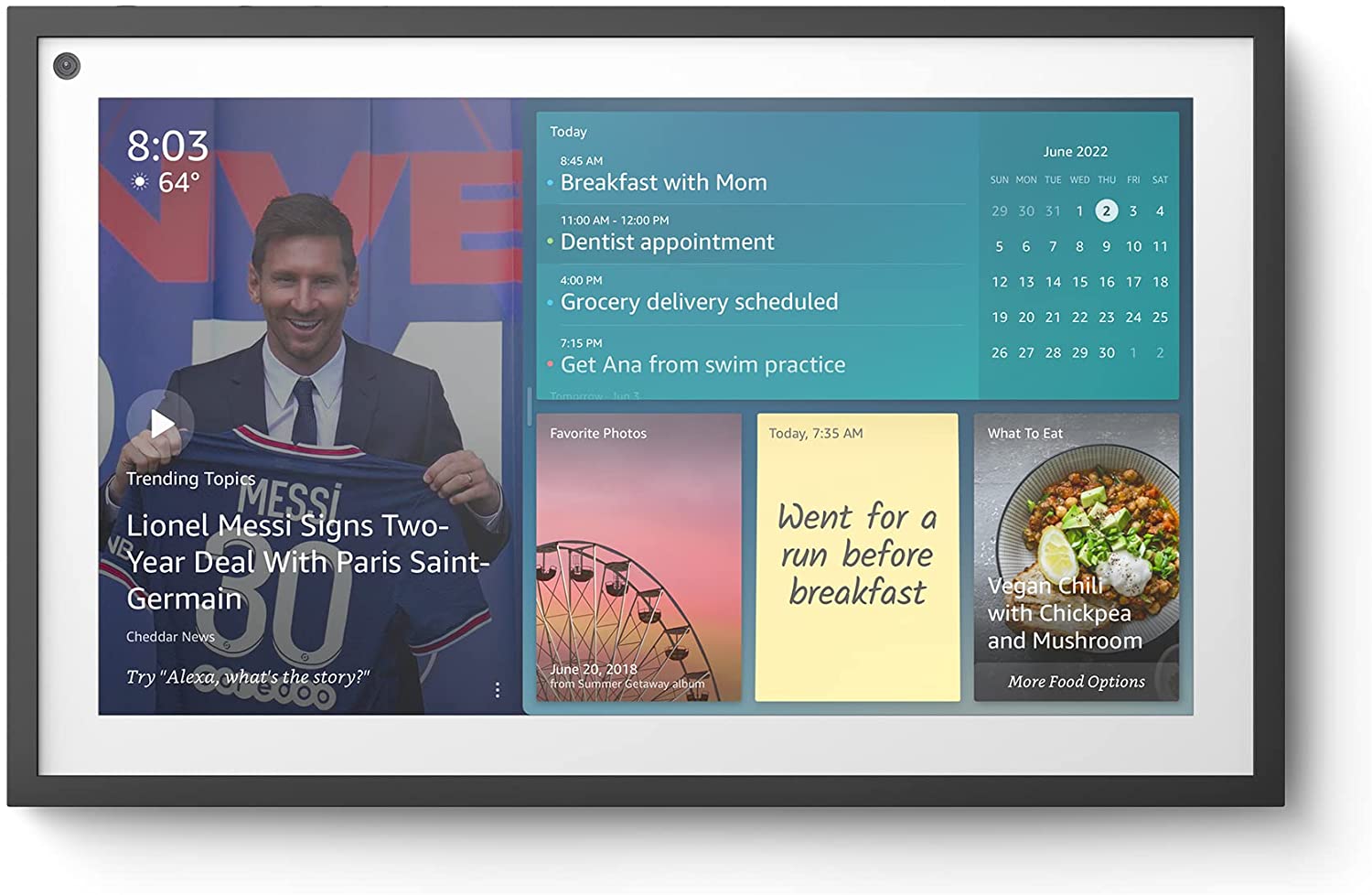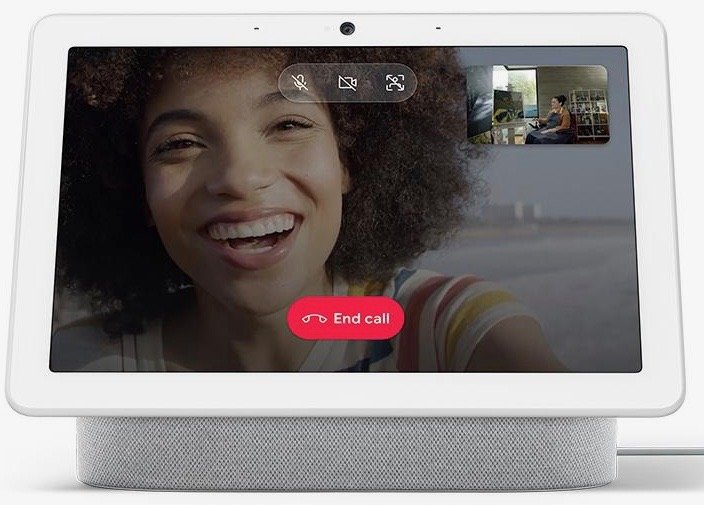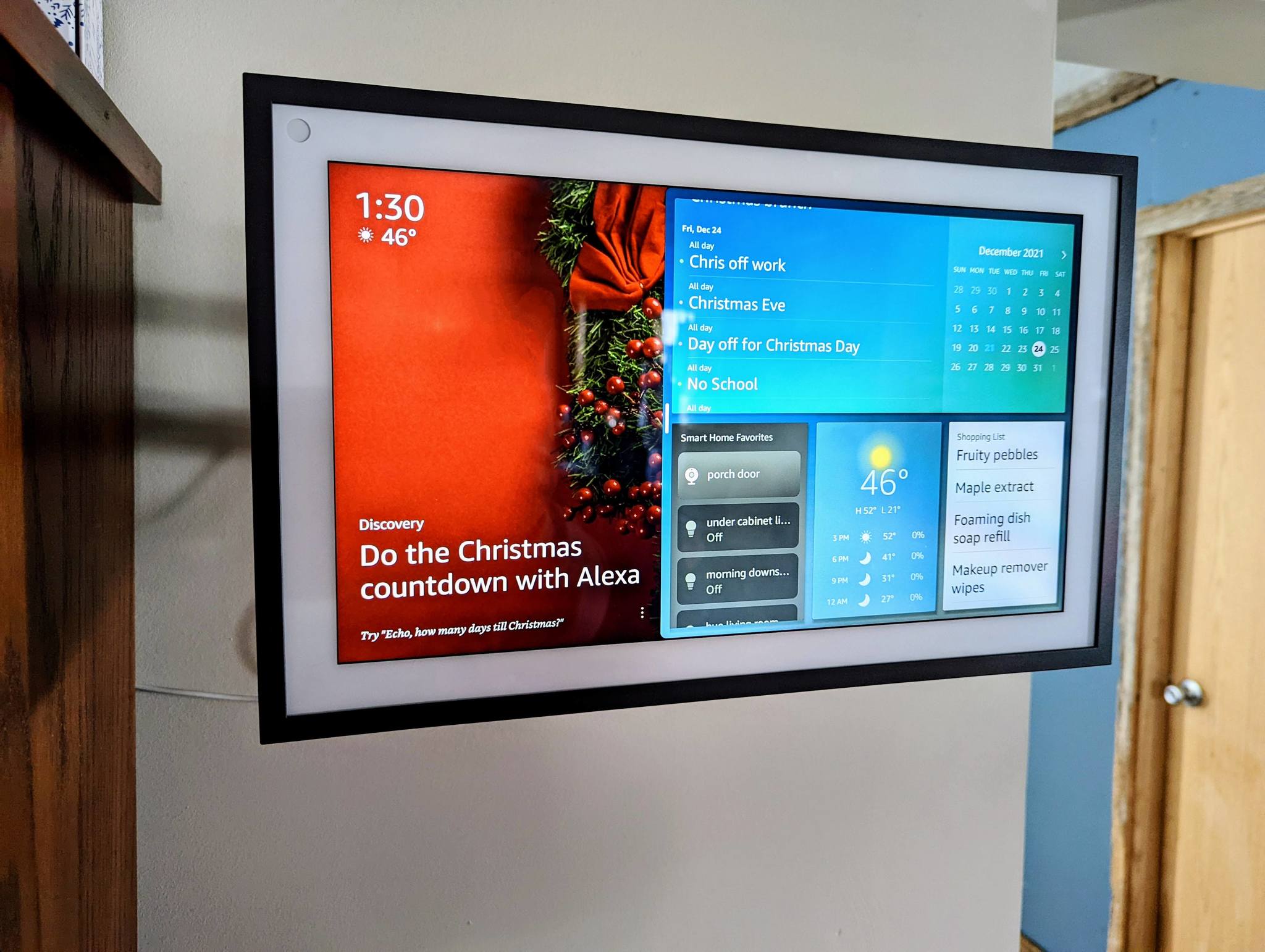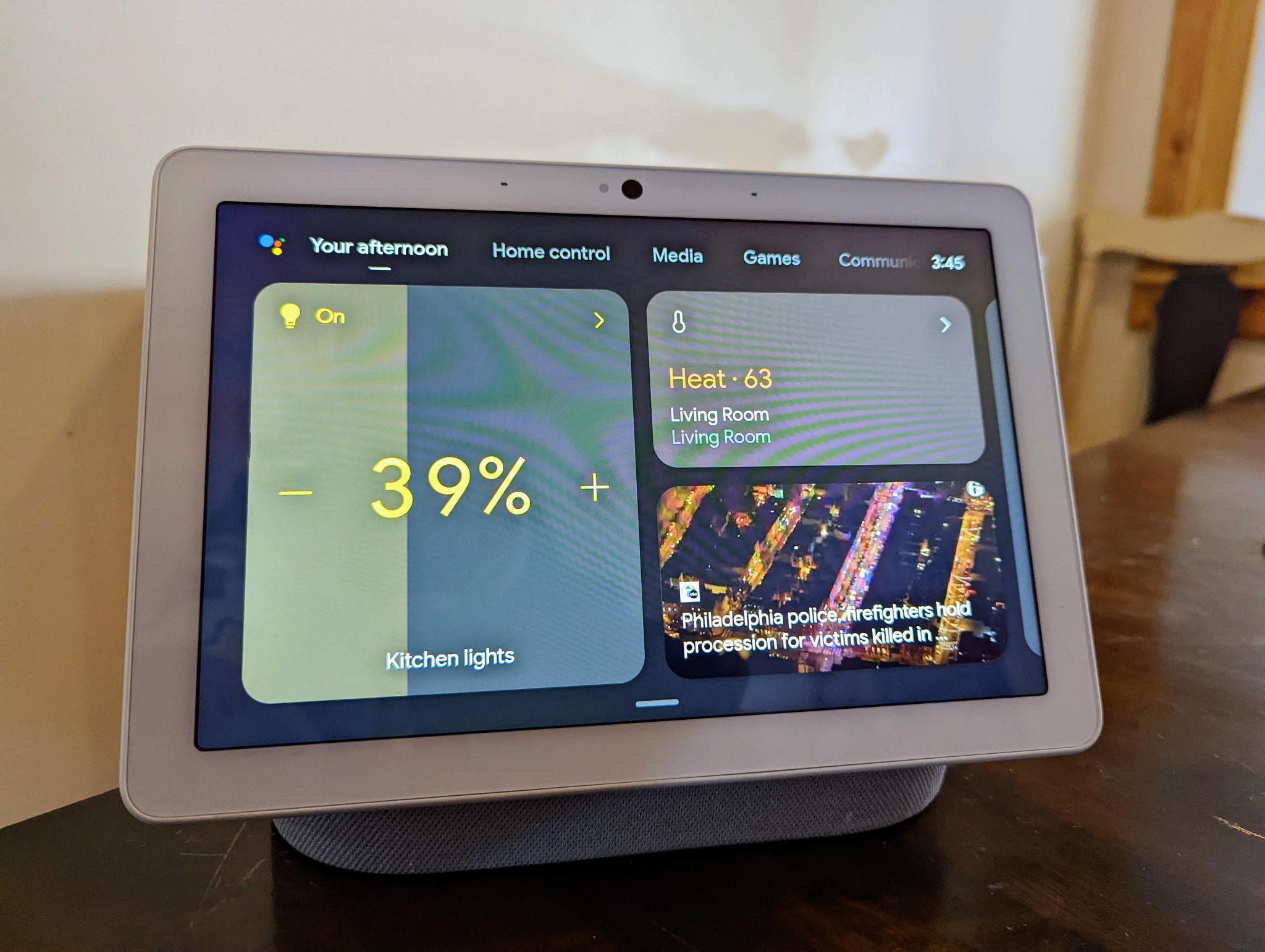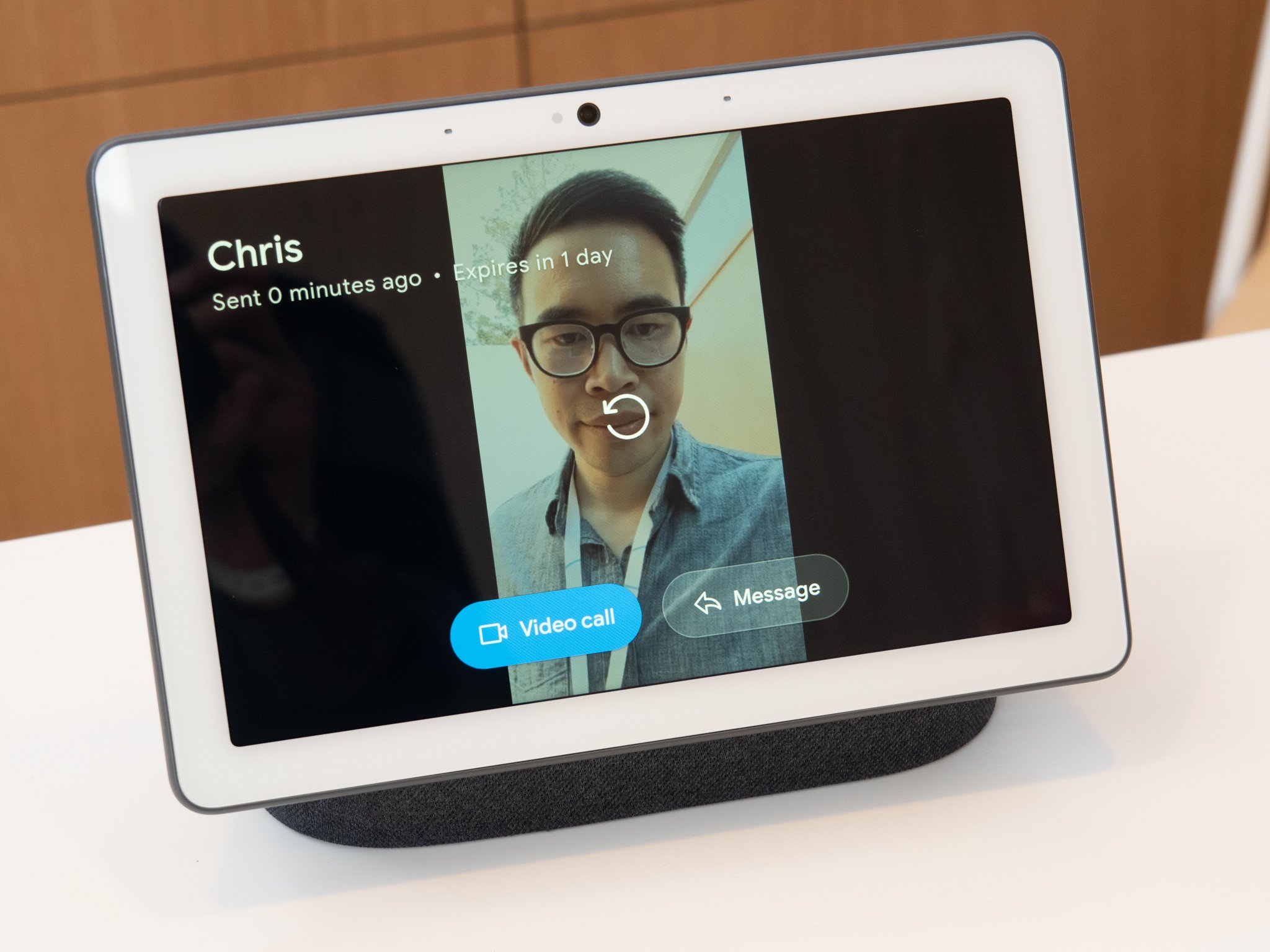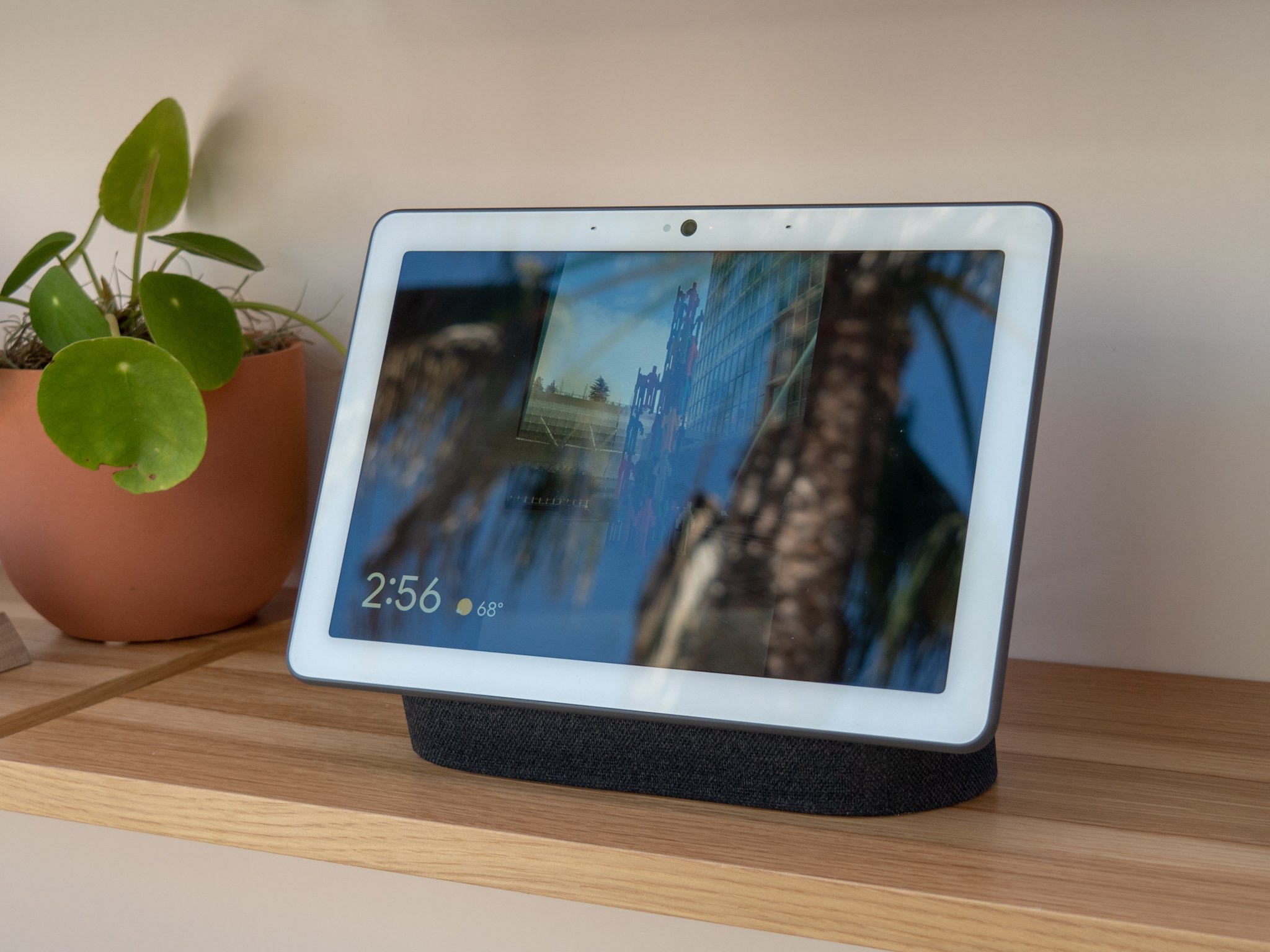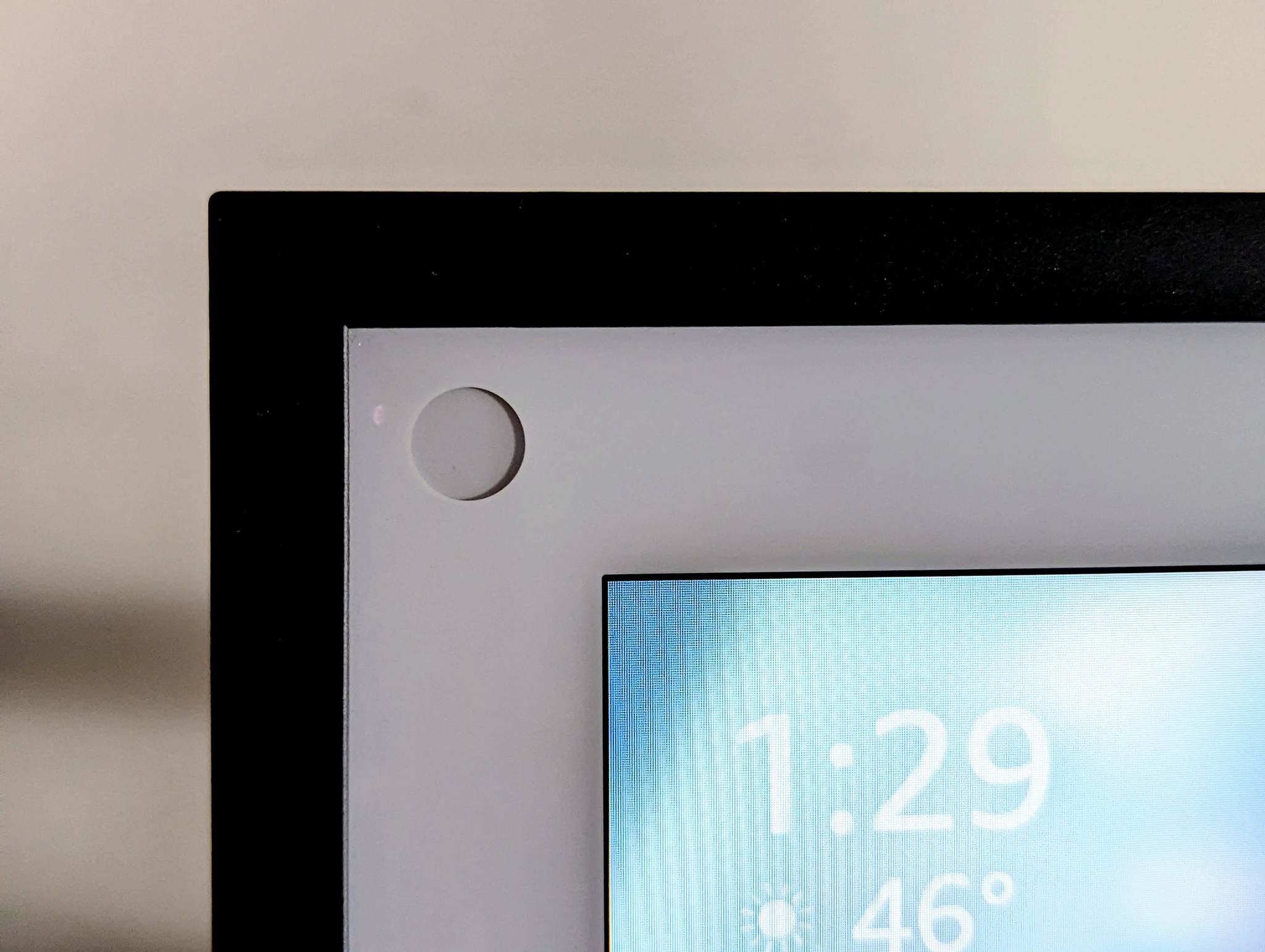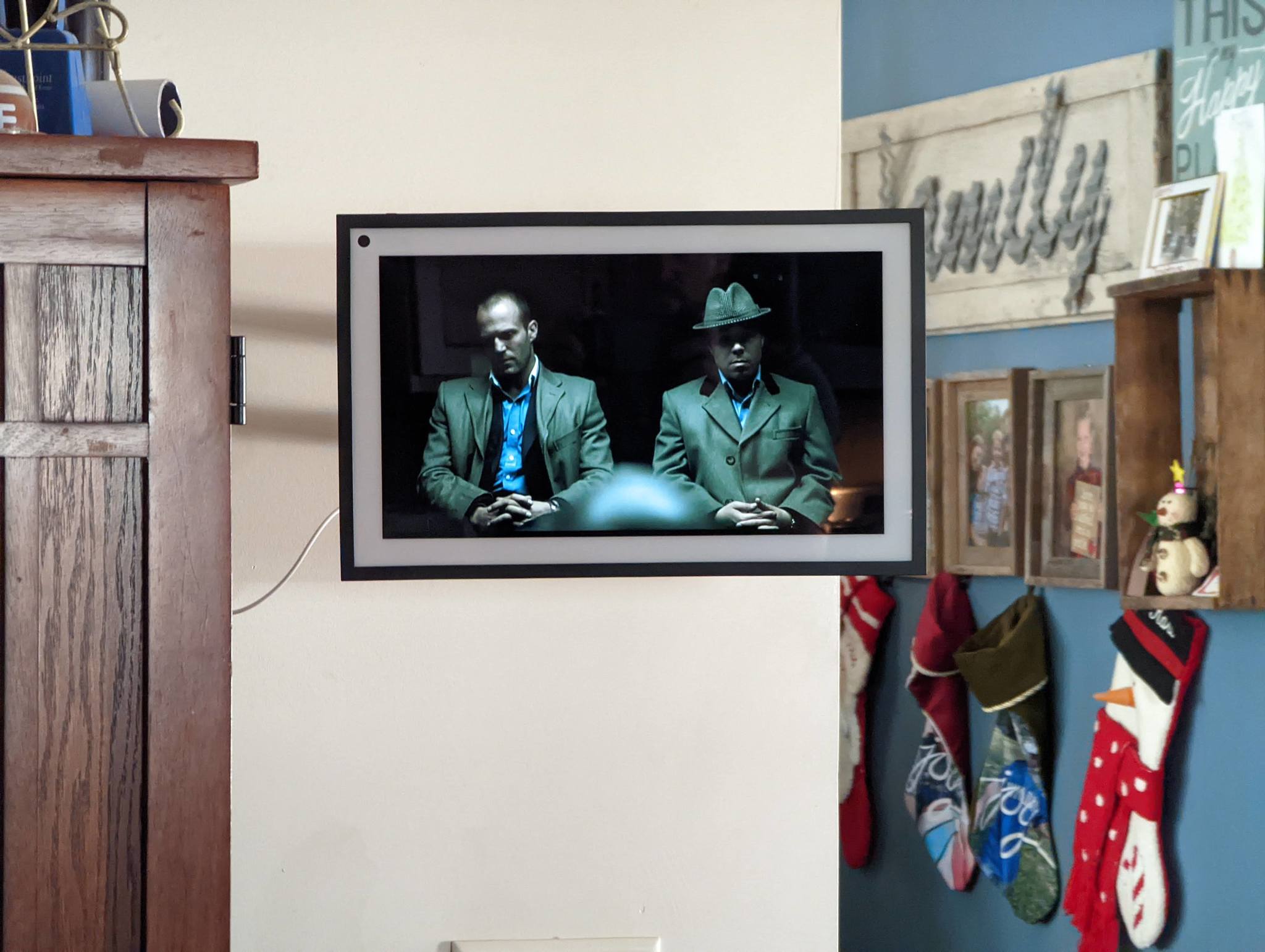The looks
Amazon Echo Show 15
Pros
- Large display is excellent for content consumption
- Wall mountable
- Alexa Widgets are great for glanceable information
- Picture-in-picture makes it good for multi-tasking
- Privacy slider for the camera
Cons
- The camera quality isn't very good
- Visual ID is inconsistent
- Lacks access to YouTube
- Audio quality feels thin
Thanks to its picture frame design, Amazon's Echo Show 15 looks great on a countertop or mounted on the wall. The customizable widgets make excellent use of the 15.6-inch display, allowing you to see the info you want quickly. While the Echo Show 15 is perfect for content consumption, the poor camera quality makes the Visual ID feature and video calling less than enjoyable.
The brains
Nest Hub Max
Pros
- Great, wide-angle camera
- Facial and voice recognition works well
- Access to YouTube and YouTube Music
- Google Assistant is extremely helpful
- The display automatic color temperature adjustment is wonderful
Cons
- Lacks customizable widgets
- No privacy shutter for the camera
- The smaller screen isn't as good for content consumption
- Slower to process commands
The Nest Hub Max shines as a smart display thanks to Google Assistant and the excellent automatic color temperature adjustment for photos. Access to YouTube is great for entertaining while cooking, and the clear, wide-angle camera makes the Nest Hub MAx great for video calling. Unfortunately, you can't cover the camera, and you can't customize the information on your display.
Amazon seems to be constantly releasing new smart speakers, and its latest is also the largest. At 15.6 inches, the picture frame-inspired design begs to be hung on the wall or rested on a countertop. On the other side of the spectrum, Google's largest smart display to date came out over two years ago, and is still smaller than the latest Echo Show. However, that doesn't mean the Nest Hub Max is obsolete. Google Assistant keeps it leading the pack in the intelligence department, as does its excellent hardware. But between these fantastic smart speakers, should you get the Amazon Echo Show 15 or Nest Hub Max? Let's see if we can help you out with that.
Amazon Echo Show 15 vs. Nest Hub Max: Making use of space
Bigger isn't always better; what does matter is that the space on offer is utilized. Until the Amazon Echo Show 15 and its 15.6-inch display, many smart display users were perfectly happy with the largest display sizes being 10 inches, which is what the Nest Hub Max offers.
However, Amazon has been continuously working on the UI for its smart displays to introduce new features to make better use of its products' screens, including Alexa Widgets. Like on our smartphones, widgets are smaller, more compact versions of a larger app on the home screen, and it works great here. Because there is so much screen real estate on the Echo Show 15, you can see glanceable information on your shopping list, sticky notes, weather, calendar, and more when you're not using it to display pictures from Amazon Photos or Facebook.
While the Nest Hub Max does offer similar types of information as well, it isn't really customizable. It's all shown automatically based on the time of day and what your Google Assistant thinks you want to see.
On the Echo Show 15, you're able to pick and choose from a handful of widgets to display on your device. Today, the only widgets available are those made by Amazon, but the company has opened up the ability to create third-party widgets for developers. The smart display also works in both portrait or landscape orientation, whether it's wall-mounted or set on a tabletop using a stand sold separately.
| Amazon Echo Show 15 | Nest Hub Max | |
|---|---|---|
| Price | $250 | $190 |
| Processor | Amlogic Pop1 SoC with Amazon AZ2 neural edge processor | Amlogic T931 |
| Smart Assistant | Alexa | Google Assistant |
| Touchscreen | 15.6" HD | 10" HD |
| Speakers | 2" x 1.6" full-range speakers | 2" x 0.7" 10W tweeters, 1" x 2.95" 30W woofer |
| Camera | 5 MP + Shutter | 6.5MP with 127º FOV |
| Privacy controls | Physical cover for camera, electronic switch for mic | Physical switch to electronically disable mic and camera |
| Wi-Fi | 802.11 a/b/g/n/ac (2.4GHz/5GHz), dual-antenna (MIMO) | 802.11 b/g/n/ac (2.4GHz/5GHz) |
| Bluetooth | A2DP, AVRCP | 5.0 |
| Chromecast built-in | No | Yes |
| Smart Home Integration | Sidewalk | Works with Google Assistant |
| Face Match | Yes | Yes |
| Voice Match | Yes | Yes |
| Gesture controls | No | Yes |
| Photos | Can display Amazon or Facebook photos on home screen | Can display Google Photos on home screen |
| Low Power Mode | Uses less power when not in use | Dims screen to ambient lighting when not in use |
| Security system compatibility | Works with Guard Plus | Works with Nest Aware |
| Can you delete old recordings? | Yes | Yes |
| Size | 15.8" x 9.9" x 1.4" | 9.85" x 7.19" x 3.99" |
| Weight | 4.88 lbs | 2.91 lbs |
Of course, with a screen as big as the Echo Show 15's, it seems obvious to use it for content consumption. Luckily, it has access to the expected streaming services like Netflix and Disney+, but one glaring omission from the providers is YouTube. This is where the Nest Hub Max starts to make up some ground. You'll have access to YouTube, Netflix, and more, while also being able to connect to Google Photos library with live albums.
One design flaw that both smart displays suffer from is rear-firing speakers. When watching something or listening to your favorite audio, the sound is focused away from the screen, which means you'll probably crank the volume far louder than necessary. However, thanks to the dedicated woofer, the Nest Hub Max has the fuller sound between these two devices.
Amazon Echo Show 15 vs. Nest Hub Max: It's about the optics
Another way the Echo Show 15 makes good use of its screen size is with picture-in-picture. This allows you to follow along with a recipe in a large view with a smaller inset feed of your security camera, for example.
However, aside from the lackluster rear-firing speakers, the camera is one of the other areas that suffers. At only 5MP, it does an OK job with video calls, but the picture comes out muddy. If you are using it in less than ideal lighting, then the dynamic range struggles, and the person on the other end will get a bad feed. The poor camera quality also contributes to the Visual ID, the feature that identifies household members for customized experiences, being hit and miss.
Where the Nest Hub Max lacks in widgets and screen size, it more than makes up for in the optical department. Even though the camera on Google's smart display isn't much higher in resolution at 6.5MP, the sensor handles video and light far better. It also has a wider field of view at 127 degrees, rather than the 110 degrees on the Echo Show 15. These metrics combine for better video call quality and far more customized experiences based on what the camera sees.
Subject tracking is also a nifty feature on the Nest Hub Max. During a video call, if you move around in the image frame, the camera will digitally follow you to make sure you remain the focus. Google manages to do this via software magic, rather than physically moving like the Echo Show 10 (3rd gen) does.
Still, on the subject of cameras, this is something more about what isn't seen. Both of these smart displays can disable the microphone and camera but do it in different ways. Disabling the microphone and camera on the Nest Hub Max is done electronically — albeit via a physical switch. In the Echo Show 15's case, the microphone is disabled with a button to electronically disconnect it. Disabling the camera is done by sliding over a physical shutter to hide it.
Amazon Echo Show 15 vs. Nest Hub Max: Getting some assistance
Both the Echo Show 15 and the Nest Hub Max are smart displays, which means there is access to digital voice assistants. On the Echo Show 15, you'll get Amazon's Alexa, and for the Nest Hub Max, there is Google Assistant. Now, the side of the Google Assistant vs. Amazon Alexa fence you're on could be a major deciding factor towards which display is better for you since each one has strengths.
In some ways, Google Assistant can be more personable because it tightly integrates into the best Android phones. This integration allows the digital assistant to get to know you, help you with tasks easier, and offer the same experience across various devices, including the Nest Hub Max.
Amazon continues to evolve Alexa's capabilities and ease of use. Both assistants can help answer questions, tell you the weather, control your smart home devices, and more. It is possible to have both in the same home if you are willing to learn the limits of each option to have the device that best fits your needs.
Amazon Echo Show 15 vs. Nest Hub Max: Which should you buy?
These two smart displays represent the biggest displays available from Google and Amazon. Both pack a lot of features into the devices, but which is best for you really comes down to a few things: need, use, and which digital assistant you prefer.
Google and Amazon both have winners to offer, but which is best for you depends on a few key factors.
Based purely on size, the Echo Show 15 wins. It isn't just big for the sake of being big. Amazon has done a good job of making use of the big display with Alexa Widgets. Customizing the info you see on the screen is unique and adds a ton of utility. If you're a busy individual managing schedules and tasks, being able to see information quickly at a glance is wonderful. The Nest Hub Max kind of does this, but it isn't customizable and offers less utility in this way.
If you want a smart display that you'll often use for watching videos, then the Echo Show 15 is also great due to its size. However, if you watch a lot of YouTube, you'll be better served with the Nest Hub Max. Both allow access to the top streaming services, but only Google's offering has YouTube. The Nest Hub Max also provides the best video calling option thanks to its far better camera and features.
Finally, while it doesn't have to be a deciding factor, it may be just that to some. If you are deeply rooted in the Google Assistant world, then you may have trouble adjusting to using Alexa on the Echo Show 15. As I said before, both are very capable digital assistants but which you are used to and your willingness to flip-flop between the two could ultimately end up being what decides for you. Whichever smart display you pick, you'll be getting an impressive device.
The big screen
Amazon Echo Show 15
Ready for prime time
$250 at Amazon $250 at Best Buy $250 at Kohl's
The 15.6-inch display is great for watching your favorite shows, as long as they aren't on YouTube, and for getting things done, thanks to Alexa Widgets. Thanks to the option of wall-mounting or set on a tabletop, the Echo Show 15 is ready to shine anywhere.
Calls and more
Nest Hub Max
Keeping in touch
$190 at Best Buy $190 at Walmart $190 at Google
Where the Nest Hub Max lacks in size, it makes up for in brains and video calling. Google Assistant offers a more personal digital assistant with the same experience on all of your devices. When it comes to video calls, you'll always be in focus and in the frame, thanks to the Nest Hub Max's great camera.
Source: androidcentral
